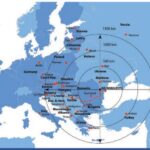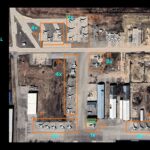American and Saudi investigators have concluded that the air attack on the Abqaiq and Khurais petrochemical facilities originated directly from Iran – not Yemen or Iraq – sources say.
The cruise missile and/or drone attack was likely staged from Iran’s Khuzestan province. As unidentified flying objects (UFOs) were spotted in Kuwait just before the attack, the kinetic platforms likely avoided the Persian Gulf, which is heavily monitored by the US Navy, and exploited a gap in Saudi Arabia’s SAM deployments. As PATRIOT radars (MPQ-53/65) have a 120 degree coverage (not 360 degrees), they were likely pointed towards the southwest and east to cover threats from Yemen and the Persian Gulf, leaving the northern approach largely exposed. When the (presumed) low-flying, slow moving and small RCS (radar cross-section) kinetic platforms entered “denied airspace” at the envelope edge of Saudi air defense systems, it was too late for the PATRIOTs detect the threat and react.

Hypothetical path of Iranian air attack on Saudi oil facilities, visualized by T-Intelligence.
Even if the MPQ-53/65 radars were pointed northwards, the PATRIOT is inadequate to intercept small drones and tactical missiles, as it is primarily an anti-aircraft and (secondary) ballistic missile defense system. Modern short-range air defense systems (V/SHORAD) are the adequate aerial defense assets for such threats, preferably aided by networked sensors and including airborne coverage from AWACS planes. While the Shahine and Skyguard SHORAD systems were guarding Abqaiq, they have a 20 km engagement range against normal sized aircraft. As the Iranian kinetic “package” consisted of low-observable munition, the engagement range was much less shorter. Alternatively, the “package’s” terrain-hugging flight profile could have masked it with the “ground clutter” or its slow speed would have filtered it out on the radar doppler. However, Saturday’s attack was as much an air defense error as it was an intelligence failure.
As Washington and Ryad disagree on how to retaliate against Iran, an official joint announcement blaming the IRGC for the attack has been repeatedly postponed. President Donald Trump is engaged in a re-election campaign and knows that the US public would not support a new conflict or military action in the Middle East. Therefore the White House opposes the US military spearheading a kinetic retribution against Iran. This leaves Saudi Arabia to either form a coalition of the willing with other Gulf states, an exhaustive and unlikely endeavour, or to act alone, which is not an option for the monarchy.
With the critical 72-hour time window for retaliation closed, it is possible that Iran might walk away unsanctioned for the “war-opening” attack on Abqaiq and Khurais. Absent red-lines, Tehran will potentially feel emboldened to prosecute other strategic targets, such as Saudi desalination plants or US bases in the Middle East.
UPDATE September 19, 2019 – Saudi officials have showcased the wreckage recovered from the Abqaiq and Khurais attacks, confirming that the air attack was conducted by Iranian Delta Wing drones and cruise missiles. US Intelligence sources also confirmed that the attack was mounted from Iran’s southwestern Khuzestan province and that the weapons were programmed to avoid the Persian Gulf.
Founder of T-Intelligence. OSINT analyst & instructor, with experience in defense intelligence (private sector), armed conflicts, and geopolitical flashpoints.







